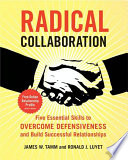

In 'Radical Collaboration', the authors emphasize that collaboration is not just a skill but a crucial mindset for success in any endeavor. They argue that the ability to work effectively with others is essential in today’s complex and interconnected world. Collaboration goes beyond mere teamwork; it involves building trust, understanding diverse perspectives, and leveraging collective strengths to achieve common goals. The authors highlight that effective collaboration can lead to innovative solutions and improved outcomes, as it allows for the integration of different ideas and expertise. They provide numerous examples from various fields, illustrating how collaborative efforts have led to breakthroughs and enhanced productivity. This idea underscores the necessity for individuals and organizations to cultivate a collaborative culture, where open communication and mutual respect are prioritized.
Continue readingTrust is the foundation of successful collaboration. The authors delve into the dynamics of trust-building, explaining that it is a gradual process that requires consistency, transparency, and vulnerability. They discuss the different types of trust—predictive trust, which is based on reliability, and emotional trust, which is rooted in personal connections. The book provides practical strategies for building trust within teams, such as active listening, showing appreciation, and being open about one’s own challenges and mistakes. The authors illustrate how a high-trust environment fosters creativity and risk-taking, as team members feel safe to express their ideas and opinions. By prioritizing trust, organizations can enhance collaboration and drive better results.
Continue readingThe authors challenge the conventional view of conflict as something negative. Instead, they present conflict as a natural part of collaboration that can lead to growth and innovation if managed effectively. They argue that conflict often arises from differing perspectives and can serve as a catalyst for deeper understanding and creative problem-solving. The book outlines techniques for addressing conflict constructively, such as reframing the conversation, focusing on interests rather than positions, and seeking win-win solutions. By embracing conflict as an opportunity for dialogue and learning, teams can harness its potential to drive progress and strengthen relationships.
Continue readingEffective communication is pivotal in fostering collaboration. The authors emphasize that clear, open, and respectful communication helps to prevent misunderstandings and build rapport among team members. They discuss various communication styles and the importance of adapting one’s approach to suit different audiences. The book also highlights the significance of non-verbal communication and active listening in ensuring that all voices are heard. The authors provide practical tips for improving communication skills, such as asking open-ended questions, providing constructive feedback, and practicing empathy. By enhancing communication, teams can create an inclusive environment where collaboration thrives.
Continue readingThe authors argue that for collaboration to be effective, it must be embedded in the organizational culture. They discuss the characteristics of a collaborative culture, including shared values, mutual respect, and a commitment to collective success. The book offers strategies for leaders to cultivate such a culture, such as modeling collaborative behaviors, recognizing and rewarding teamwork, and providing opportunities for team-building activities. The authors also stress the importance of aligning organizational structures and processes with collaborative principles, ensuring that teams have the resources and support they need to work together effectively. By fostering a collaborative culture, organizations can enhance employee engagement and drive better performance.
Continue readingThe authors highlight the critical role of diversity and inclusion in enhancing collaboration. They argue that diverse teams bring a wealth of perspectives and experiences that can lead to more innovative solutions. The book discusses the challenges that can arise in diverse teams, such as communication barriers and unconscious biases, and provides strategies for overcoming these challenges. The authors emphasize the importance of creating an inclusive environment where all team members feel valued and empowered to contribute. By prioritizing diversity and inclusion, organizations can unlock the full potential of their teams and drive better outcomes.
Continue readingThe authors advocate for a mindset of continuous learning and adaptation as essential components of successful collaboration. They argue that in a rapidly changing world, teams must be willing to learn from their experiences, adapt to new challenges, and seek out opportunities for growth. The book provides frameworks for reflective practice, encouraging teams to regularly assess their collaboration processes, identify areas for improvement, and celebrate successes. The authors also stress the importance of being open to feedback and embracing change as a catalyst for innovation. By fostering a culture of continuous learning, organizations can enhance their collaborative capabilities and remain competitive in an ever-evolving landscape.
Continue reading